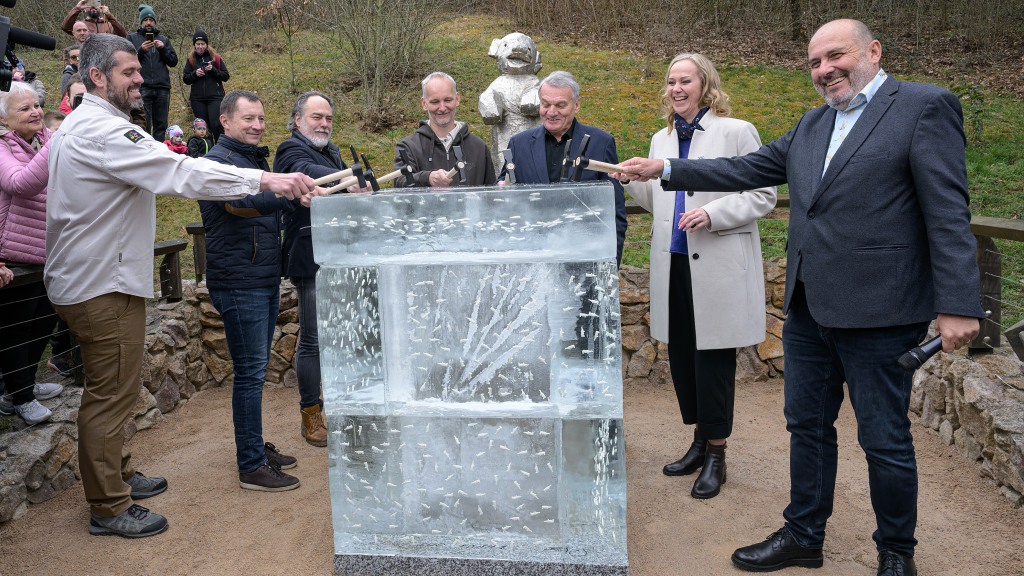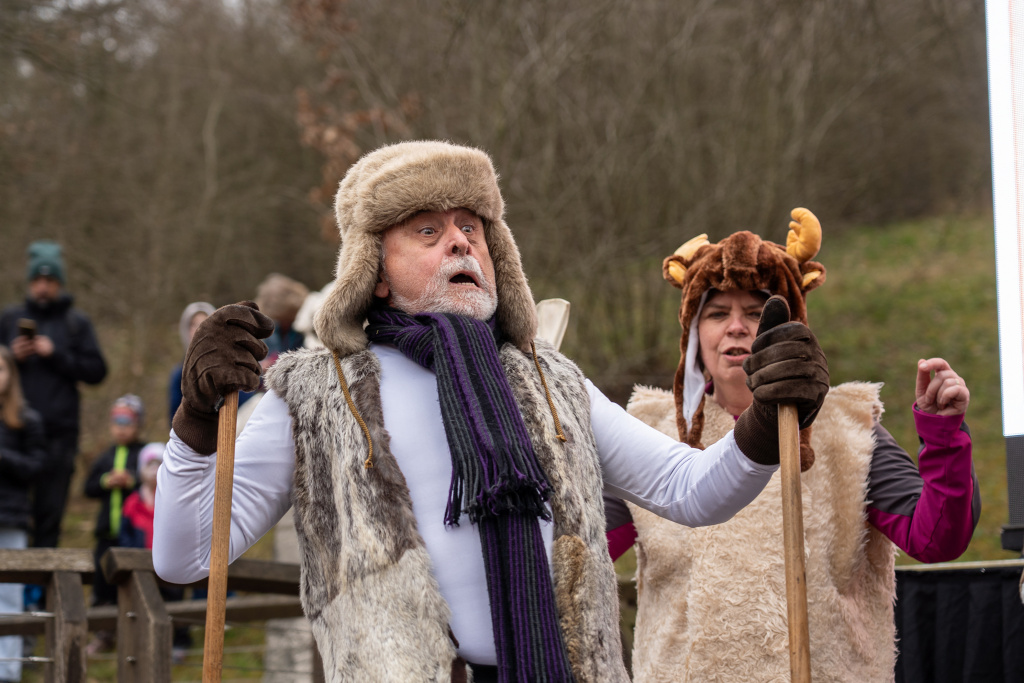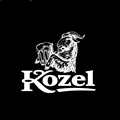Prague Zoo launches its 94th season and starts construction on the Arctic exhibit
29. 03. 2025
Today, Prague Zoo officially opened its 94th season. To mark the event, Prague Zoo’s director, Miroslav Bobek, the Mayor of Prague, Bohuslav Svoboda, and his deputy, Jana Komrsková, symbolically tapped the foundation stone of the Arctic exhibit. The plaque, with a motif of a polar bear by world-famous illustrator Petr Sís, was enclosed in a huge ice cube. Visitors chipped away at it to get to the tiny polar bear figurines. Each bear, of which there are thousands, contains a chip to be used as a ticket for a future visit. At the same time, Prague Zoo opened the Ball’s Pyramid exhibit for the unique Lord Howe Island stick insects. It also launched its summer guided animal feedings and extended the opening hours until 6 pm.

The symbolic tapping of the foundation stone for the Arctic exhibit complex, or rather the giant ice cube, was carried out by (from right) Bohuslav Svoboda, the Mayor of Prague; Jana Komrsková, Prague’s Deputy Mayor for the Environment; Miroslav Bobek, Prague Zoo’s Director; Lukáš Divoký, Prague Zoo’s Deputy for Investment; and Pavel Brandl, Curator of Mammals. Photo: Petr Hamerník, Prague Zoo
Miroslav Bobek, Prague Zoo’s director, said, “Polar bears have been at Prague Zoo almost since it was founded, and for more than 90 years, they have achieved huge successes—I’m thinking of the first artificially reared cub, Snow White, born during the Second World War, or the legendary Polárka, who lent her name to the popular ice cream. Without the new Arctic exhibit, our efforts to breed polar bears would come to an end.”
The Arctic exhibit complex will spread out over the zoo’s northern part, near Gočár’s Houses. At over 8,000 m2, the polar bears will be provided with first-class living conditions: large enclosures, swimming pools, several types of surfaces and even a “bear maternity ward”, offering the female a quiet place to give birth and raise her cubs.
In his speech, the Mayor of Prague, Bohuslav Svoboda, said, “The word ‘Arctic’ refers to an entire region made up of many small islands. Today, we are beginning to create another of these Arctic islands, which will also be home to polar bears, as they rightfully belong here. I believe that polar bear breeding in the new exhibit will be just as successful as all the other work carried out by Prague Zoo.”

The huge ice cube by the foundation stone of the Arctic exhibit contained thousands of frozen polar bear figurines that hid a chip. These are exact replicas of an Inuit carving in walrus ivory. The original is on display at the Náprstek Museum. The chip will serve as a free ticket to visit the zoo. Photo: Petr Hamerník, Prague Zoo
Harbour seals will also find a home in Prague’s Arctic. Visitors will be able to watch them from the amphitheatre or from the neighbouring restaurant, which will specialise in fish dishes. The exhibit will also feature themed art and educational elements. The leitmotif running through the entire exhibit will be the story of the adventurer and palaverer Jan Eskymo Welzl, brought to life through original illustrations by world-famous artist Petr Sís.
Jana Komrsková, Deputy Mayor of Prague for the Environment, said, “When selecting the contractor for the Arctic exhibit, Prague Zoo once again demonstrated that it is an outstanding contributory organisation that does not shy away from a large-scale project worth hundreds of millions of crowns. It is by no means always the case that municipal contracts are carried out so smoothly here in Prague, and what’s more, it was significantly cheaper than originally estimated. On behalf of the capital, the citizens of Prague and, of course, the polar bears, I want to express my huge thanks to Director Bobek and his entire team for their excellent work.”
At the opening ceremony, visitors were entertained by performances by singer-songwriter Michal Horák and actors from the Václav Theatre in Zábřež, who gave the audience a taste of their play tracing the fate of Jan Eskymo Welzl.

One of the most striking parts of the day’s programme was a brief excerpt from The Great Wanderer, a play about Jan Eskymo Welzl by the Václav Theatre in Zábřež. Photo: Oliver Le Que, Prague Zoo
Another item on the busy agenda was the opening of the Ball’s Pyramid exhibit. This is the name given to the sea stack in the South Pacific where the critically endangered Lord Howe Island stick insect (aka the tree lobster) miraculously survived. The species was wiped out by rats in its home, Lord Howe Island, at the end of the 1910s. The world’s largest flightless insect was then “resurrected” when it was discovered on an inhospitable rock just off the island in the 1960s, first by climbers and later by scientists. In 2003, conservationists collected four individuals and established a captive breeding programme. The entire fascinating story can be found at zoopraha.cz/en/pyramid
Vojtěch Víta, Prague Zoo’s Invertebrate Specialist, said, “As of today, we are the only zoo in continental Europe to put Lord Howe Island stick insects on display for the public. The breeding centre and visitor areas, with their gigantic model of Ball’s Pyramid, a larger-than-life statue of a tree lobster, and beds and greenhouses for growing food plants, are unparalleled anywhere in the world.”

A 3D model of Ball’s Pyramid is on display in the exhibit bearing the same name and dedicated to the planet’s largest non-flying insect, the Lord Howe Island stick insect. Photo: Oliver Le Que, Prague Zoo
The best way to get acquainted with the “tree lobsters” is through a guided tour for CZK 200, which starts every day at 2.30 pm from the entrance to the Ball’s Pyramid exhibit next to the Bororo Reserve in the lower part of the zoo. On Fridays and Saturdays, the price will be a hundred crowns more, but there will be a bonus: a peek behind the scenes at the tree lobster breeding facilities under the expert guidance of their breeder (English language tours may be arranged). School groups can contact the Education and Programmes Department at skoly@zoopraha.cz, which offers a variety of educational programmes tailored to different age groups.
Prague Zoo has also launched its summer programme of guided feeding sessions and animal encounters. After the winter break, people will be able to watch the meerkats and lemurs being fed, or observe the popular Cape fur seal training. The schedule is also available on the Prague Zoo mobile app, where people can even purchase a ticket to the zoo—all at a bargain online price.








